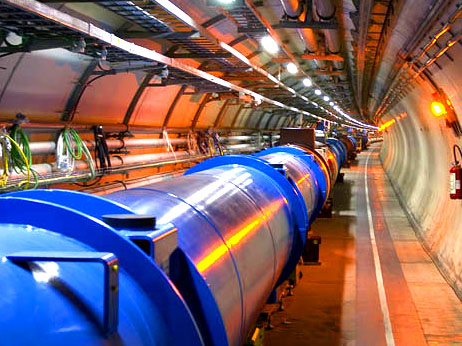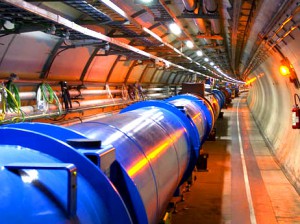Large Hadron Collider Sets New World Record


Already holding the world record for smashing protons together at 7 trillion electron volts, the Large Hadron Collider, or LHC, is now adding world’s brightest beam to its list of records. The intensity of a beam is one way of measuring how many collisions occur in the 17 mile long collider tunnel, and the higher the intensity, the higher the number of impacts. With a higher number of impacts, comes more data, and increases the likelyhood of finding the famed Higgs Boson Particle. The LHC broke the previous record last year.
A leaked internal memo from physicists working at the Large Hadron Collider near Geneva reports a early signs of the Higgs boson particle that could make or break the standard model of particle physics. The preliminary note, which is still under review, was posted April 21 in an anonymous comment on physicist Peter Woit’s blog, “Not Even Wrong.†Four physicists claim that ATLAS, one of the LHC’s all-purpose particle hunting experiments, caught a Higgs particle decaying into two high-energy photons — but at a much higher rate than the standard model predicts.
Geneva, 22 April 2011. Around midnight this night CERN1’s Large Hadron Collider set a new world record for beam intensity at a hadron collider when it collided beams with a luminosity of 4.67 × 1032cm-2s-1. This exceeds the previous world record of 4.024 × 1032cm-2s-1, which was set by the US Fermi National Accelerator Laboratory’s Tevatron collider in 2010, and marks an important milestone in LHC commissioning.
“Beam intensity is key to the success of the LHC, so this is a very important step,” said CERN Director General Rolf Heuer. “Higher intensity means more data, and more data means greater discovery potential.”
Luminosity gives a measure of how many collisions are happening in a particle accelerator: the higher the luminosity, the more particles are likely to collide. When looking for rare processes, this is important. Higgs particles, for example, will be produced very rarely if they exist at all, so for a conclusive discovery or refutation of their existence, a large amount of data is required.
The current LHC run is scheduled to continue to the end of 2012. That will give the experiments time to collect enough data to fully explore the energy range accessible with 3.5 TeV per beam collisions for new physics before preparing the LHC for higher energy r




